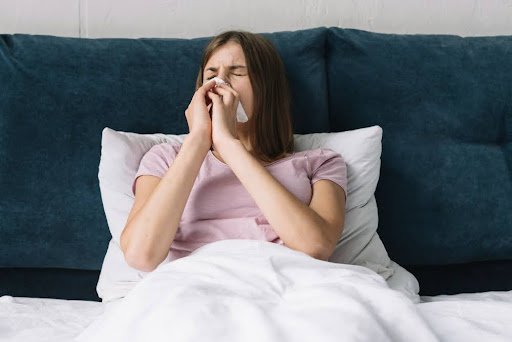
You may be wrapping yourself in the same duvet for a restful night if you experience problems with sneezing, itching, or having a stuffy nose when waking up. As it stands, you can see why you are allergic to this duvet, whether it’s the filling or the cover material. Some people even argue that this is one of the reasons you should think about anti-allergy duvets. With the Best Anti-Allergy Duvet, which is specifically made to guard against microorganisms as well as allergens for a more comfortable and healthy sleep, you may sleep peacefully every night.
An anti-allergy duvet should be the only remedy for many issues. According to the duvet tog recommendations, these duvets are composed of premium fabrics that are intended to shield each tog against seasonal and household allergens.
How Allergies May Be Caused By Your Bedding
Allergens naturally congregate and adhere to surfaces in bedrooms. Large surfaces in the room, particularly in the mattress, allow dust, pet hair, skin flakes, dampness, and other allergens to gather and remain latent for extended periods of time.
Sleepers, including those with allergies, typically do not wash or replace their bedding as frequently as they ought to, which is roughly once every three to four months for males and every four weeks for women. This indicates that many of us are encasing ourselves in allergens night after night for weeks on end, which only gets worse.
Typical Allergens In Your Mattress
Let’s first identify the common suspects that may be present in your bedding before delving into how anti-allergy clothing functions:
- Dust mites: The most common cause of allergies is these microscopic organisms. They flourish in heat, humid settings, including your mattress, and prey on useless skin cells.
- Pet Dander: Your bedding can also become contaminated through your puppy’s dander, even if they do not sleep on your mattress.
- Pollen: These tiny debris have the potential to travel through your home and land on your bedding, which could cause congestion and sneezing.
- Mould Spores: Your bedding can also become a haven for mould if it isn’t wiped clean or allowed to air out.
Anti-Allergy Bedding Types
You have choices when it comes to anti-allergy bedding! Let’s examine the many kinds of bedding that might assist you in creating a more wholesome sleeping environment.
Pillows that prevent allergies
In terms of harbouring allergies, pillows are frequently the main offender. Hypoallergenic materials, such as memory foam or synthetic fibres that are resistant to mould and dust mites, are used to make anti-allergy pillows.
However, how can you pick the best one? Think about how you sleep. While keeping allergens at bay, the ideal anti-allergy pillow and pillowcases should offer support.
Duvets With Anti-Allergens
Dust mites can also thrive on your duvet. The densely woven covers and hypoallergenic contents of anti-allergy 15 duvet tog singles provide a barrier against allergens. To keep allergies under control, always choose one that is easy to wash, regardless of your environment and personal preferences.
Protectors For Mattresses Against Allergies
The very first line of defence against allergens in your mattress is a mattress protector. Extra deep mattresses protectors with anti-allergy properties are made to enclose the sleeping surface protector and keep allergens out. Additionally, they are typically waterproof, shielding your mattress from stains and accidents. For optimal protection, search for a waterproof mattress protector with anti-microbial protection and a tight weave.
Anti-Allergy Pillowcases And Sheets
These are the necessities for daily bedding. Materials like microfiber or cotton with a significant number of threads are used to make anti-allergy sheets and pillows, which can help ward off allergens. How should your anti-allergy sheets be maintained? To stop mould and mites that cause allergies from growing, wash them frequently at a high temperature and make sure they are completely dry.
Pick A Choice That Is Suitable For People With Allergies And Asthma.
By reducing the effects of allergens like mould and dust mites, anti-allergic reaction or allergy-sensitive bedding (pillows, quilting, pillow protectors, mattress bed protectors, bed mattress toppers, sheets, and more) may assist you in better controlling your symptoms of allergy if any members of your own family are afflicted by allergies or hypersensitive reaction-associated situations. They additionally promote better sleep with the aid of suppressing dangerous mould and odour-causing germs, so even if you’re lucky enough not to have a person at home stricken by these situations, it is probably a good concept to use them, that (and lots of do).
Final Words
Anti-Allergy reaction bedding is in reality something to think about in case you’re unwell of waking up with a stuffy, sniffy nose or in case you’re just seeking to make your napping environment healthier. With advanced sleep and fewer allergic reaction signs and symptoms, it’s an investment in your fitness and wellbeing that could pay dividends.
As the writer and founder of this blog, I share insights on Tech, Business, Media, Games, Apps, Gadgets, Cybersecurity, Web Development, Podcasts, and Cryptocurrency. My mission is to educate and inspire with engaging, SEO-friendly content that keeps you ahead in the digital landscape.
